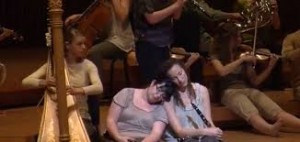[contextly_auto_sidebar id=”7AvneDP3QsFnKhR45OJpSm0moIBSuDkC”]
I blogged awhile ago about the extraordinary Appalachian Spring, performed by the University of Maryland Symphony Orchestra, with the musicians playing from memory and dancing. Now there’s a video. Watch it! I think you’ll be inspired.
And if you haven’t seen it, you also might watch the group’s earlier video of Afternoon of a Faun, also played from memory and danced. These two performances, Faun and Appalachian Spring, are some of the most extraordinary musical work being done in the US, probably in the world. They demonstrate how much creativity — life-affirming, for both musicians and audience — there can be in classical music.
Faun has a simple video. The one for Appalachian Spring is more carefully produced, a professional job, a creative work in its own right, not just a record of the performance.
And the treatments of the two pieces — both choreographed by Liz Lerman — weren’t the same. In Faun, the movement all came from the music. In Appalachian Spring, there were two dancers on stage, along with the musicians, playing prominent parts. So while what the musicians did still was impressive — deeply moving — what we saw was more of a dance piece than Faun had been.
The video, to my eye, amplifies the purely dance elements, by focusing on the two dancers. So then I get less of the physical and inspirational impact of the musicians than I did when I saw the piece live.
But that’s just me. The response to this video, from everything I’ve heard, has been overwhelmingly positive. Ecstatic, even.
I want to be clear about what I think this means. I’m not saying that all orchestras now should start dancing their performances. The moral of the story, for me, would be more like: If this is possible — Faun and Appalachian Spring — what else could we do?


Inspiring? Yes. Moving? Yes. Thank you, Greg Sandow for digging up all these wonderful stories-told-through-music and sharing them!
It’s nicely done, I suppose, if you must do this sort of thing. But when I go to an orchestral concert, I’m there for the music, not for this sort of thing. To me, this doesn’t tell the audience “this music is worth your time and attention,” it tells them “we have so little faith that you’ll enjoy the music that we feel compelled to trick it out with distractions.” I used to sing in a chorus that was fond of “chorusography,” and it annoyed me as a performer, too.
Nice work by the group. Movement and music is hard. ask any marching band.
And before the MB haters come on with the “it’s not the same thing…” why not check out the Broadway show Blast!
For your pleasure, a light piece and a more artistic piece. First, Officer Krupke
https://www.youtube.com/watch?v=KldTIAZmoe0
And why not just post their version of Simple Gifts and Appalachian Spring.
https://www.youtube.com/watch?v=igWsVY2hemo
There’s dance, marching band style movement, a trombone on a unicycle,
People seem to not understand that marching band includes a huge amount of standard choreography. I remember doing a version of Simple Gifts with a HS group, and we put in the same do-si-dos that you see in the UMD video (around the 13-14 mark was where I was thinking).
The moral of the story for me is the type of blinders artists must have on to think this is amazing or unique. It’s great–movement can tell stories that music can’t alone. If it couldn’t, there wouldn’t be much use for, well, dance in general. What’s novel is that it’s an orchestra doing it. Good for them, it makes for some nice marketing. It can definitely bring people into a performance.
I think the fact DCI sells out stadiums can speak to the power of these things, even if the more “artsy” people will say this is entirely different. Really, it’s not, except that the lines aren’t as straight, and the moves aren’t as clean…and there are strings and double reeds (though I have seen solo oboes and bassoons used in marching bands, though always on the side…being outside can cause some major issues there).
Great video, nice performance. Maybe everyone will take the MB world a bit more seriously? Or at least re-examine why a show like Blast! was so wildly popular on Broadway (it also won a Tony and an Emmy).